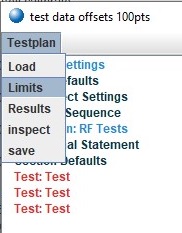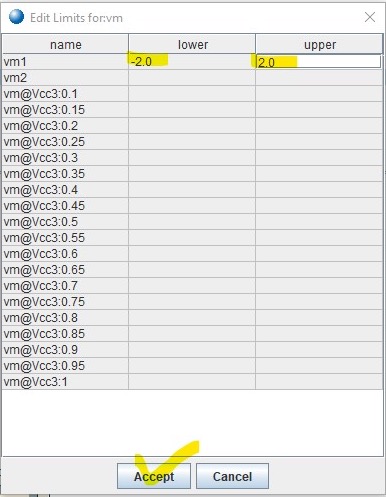Saturn for rTalk for Advantest SmartTest is Java application that controls Cassini TIMs from any supported operating system. This document focuses on the basic operations of the Saturn platform.
Saturn Update Procedures:
- Latest Saturn Updates
- To Update Saturn via .GZP
Latest Saturn Updates:
SaturnUpdate 20221024.gzp - Saturn v55, Fixed premeasure pulsing measurement, pulse droop measurement, added saving Cal data when only one cal/verify testplan run from the CalExec, added Import testplan limit files from another testplan, added Saturn version save in the STDF file EXEC_VER field.
To Update Saturn via .GZP:
- Close Saturn ("Rtalk v1 on..." window) if it is currently running by clicking the close icon (red X in the upper right corner) and choose Yes when asked "Exit main application?" from a Confirm prompt, as shown in Figure 2.1.
- Choose Login from Guru and enter valid Guru user credentials.
- Choose Apps > Guru Browser to Launch Guru Browser.
- Choose Guru Import List tab.
- Choose Get Import File(s), navigate with Look In drop down menu to locate the .GZP and choose Import to add it to the Guru Zip Files to Import list shown in Figure 2.1.
- Choose Import to upload the contents of the update into Guru and then Close Guru Browser.
- (Optional) Follow specific update/distribution instructions that accompany package.
For Major Updates Only: Remove the Saturn system cache folder in the "%USERPROFILE%\RiApps\GuruApps\GF10RE2A\tmp" directory, as shown in Figure 1.
STDF Output Directory: edit "%USERPROFILE%\RiApps\GuruApps\GF10RE2A\bootCassini.txt" file; under :ACTIONS; line with "RtalkDatalogCache", after "+stdfDir=\path\to\data" then close and restart Saturn. (See Figure 9.13), - Choose Apps to confirm an updated version number should appear Saturn v##, as shown in Figure 3 and then choose Saturn to launch the application.
Using Saturn:
- To Diagnose Cassini with Saturn
- To Open a Test Exec (RiTestSessionDef)
- To Open a Testplan (change most settings & limits, Compile & Run)
- To View the Worksheet and Save CSV from Saturn Testplan
- To Save CSV from the testplan run results Worksheet
- To Change Limits with Saturn Testplan
- To Modify Instrument Settings from testplan
- To Calibrate (RiCalList)
- To Save CSV from Cal Results
To Diagnose Cassini with Saturn:
- Launch Saturn and wait for "Tester Loaded." shown in the message window. Start a 20 minute timer to allow instruments to warm up.
- Unlatch the Fixture if it is attached and Latch the Diag/Cal Interface plate (see Diagnostic Kit).
- From Saturn app, choose apps > cassini, select equipment and choose Launch app form the right mouse button menu.
- From the equip pool window, choose refresh from the right mouse button menu.
- From Saturn app, choose apps > browse tester and confirm the Fixture is similar to "ACME bottomplate ##"
- From Saturn app, choose apps > cassini, select cal exec and choose Launch App from the right mouse button menu.
- Choose File > Diag List and select the appropriate Diag list (likely "Acme Rev A").
- Select ALL service plans (CTL+A or CTL+left mouse button click) and choose choose Run Selected from the right mouse button menu.
- If any FAIL results are found, follow the steps below to Send Diagnose Results to [email protected]. If all results PASS, proceed To Calibrate Cassini 16 with Saturn below.
- Close the cal exec window.
- Saturn is launched at Guru startup. If not, choose Apps > Saturn v## to launch the Saturn system software and wait for the message window show "Tester loaded", as shown in Figure 4.
If the compile fails, follow "To Validate Fixture is Activated vs unknown node:" steps above. - From the Saturn launch window, choose apps > cassini and double click on test exec, as shown in Figure 9.1, to open the Exec user interface.
- Select the Test Exec (RiTestSessionDef) by title, then choose on the select and Saturn will compile the testplan. (See Figure 9.2 and 9.3)
- From the RI Testexec window, enter Lot, Data Code, choose a Device from the list (Figure 9.3), enter Comment and DIB ID. as shown in Figure 9.4.
- Press Start, the worksheet will open and the Stop, Test and Retest buttons will be enabled. The Lot, Date Code, Device, Comment and DIB ID fields are disabled and can not be modified until Stop is pressed. The PartID, Result, Hardbin and Softbin values for the last tested DUT is displayed, as well as update the Total and Passed counts for the lot. (See Figure 9.6)
- The testplan runs and records the data with the current PartID value, the Retest button will run the testplan and use the current PartID. (See Figure 9.7, Figures 9.9 and 9.10) Or the user can modify the Next part field then choose Test, as shown in Figure 9.8. For example, the next part id is "21" or accept the automatically incremented part id.
- Choose Stop button to end the lot, output STDF file in the STDF Directory (defaults %USERPROFILE%\RiApps\data) with the file name of <Lot id>_<lot-end time>.stdf, as shown in Figure 9.11, and the .rtidb stored in the Saturn app Cache directory (%USERPROFILE%\RiApps\GuruApps\GF10RE2A\tmp\dataCache).
- Notice the Start button is now green, and the user input fields are enabled (do not have to re-compile the testplan). Repeat the 4 steps above with the next lot using the same Exec or close when complete.
- From the Saturn launch window, choose apps > cassini and double click on cal exec to open the Cal Exec user interface.
- Choose Actions > Open List and choose the Cal List.
- Choose Actions > Load Cal Kit and choose the appropriate entry. RiCalKit naming convention sets the date as the last valid cal date and should be checked if in the past. The Cal Kit contains the Open Coefficients and Noise Source ENR table and should be valid.
- Choose Actions > Calibration List and select the appropriate entry (likely "Acme Rev A")
- Select pairs of testplans Cal/Validate by holding the CTL key and left clicking on each testplan name and choose Run Selected from the right mouse button menu.
- Follow the user prompts. These often require connecting PKZ#12 adapters to either a Power Sensor, SMA cable, and OSL standards. (See Figure 1 and Figure 2)
IMPORTANT: ALWAYS follow good RF connector hygiene and use a SMA Torque wrench when tightening and avoid rotating the inner cable, ALWAYS rotate the outer nut. - Repeat until the list is completed. Cal data is ONLY saved after every successful validate. If a validate fails, repeat all selected Cal plans.
- From the Saturn launch window, choose apps > cassini and double click on cal exec to open the Cal Exec user interface.
- Choose Actions > Open List and choose the Cal List.
- (Optional) Choose File > Load Cal Kit and choose the appropriate entry. RiCalKit naming convention sets the date as the last valid cal date and should be checked if in the past. The Cal Kit contains the Open Coefficients and Noise Source ENR table and should be valid.
- Choose File > Calibration List and select the appropriate entry (likely "Acme Rev A")
- Follow the user prompts. These often require connecting PKZ#12 adapters to either a Power Sensor, SMA cable, and OSL standards. (See Figure 1 and Figure 2)
IMPORTANT: ALWAYS follow good RF connector hygiene and use a SMA Torque wrench when tightening and avoid rotating the inner cable, ALWAYS rotate the outer nut. - Repeat until the list is completed. Cal data is ONLY saved after every successful validate. If a validate fails, repeat all selected Cal plans.
To Save CSV from the Cal Results:
- From the Cal List window, choose Actions > Results.
- From the Worksheet, choose Data > Save Csv to convert the data in the worksheet to a .csv file in the %USERPROFILE%\RiApps\data directory.
NOTE: If the .csv file does not appear, follow steps "To Setup Python3 For Saving Results as CSV" above. (Administrator access required)
To Register a New Fixture:
- When a new Fixture is attached to Cassini, follow these steps to associate it with a Fixture Definition by saving Cal Data.
- From the Saturn launch window, choose apps > cassini
- Add a New Fixture Def
- Save Calibration
- When a new Device Interface Board (DIB) is attached to Cassini, follow these steps to associate it with a Fixture Definition by saving Cal Data.
- From the Saturn launch window, choose apps > cassini
- Add a New DIB Def
- Save Calibration
- When a replacement TIM is attached to Cassini, follow these steps to associate it with a Tester Definition by saving Tester Def.
- From the Saturn launch window, choose apps > cassini
- Save Tester
Figure 2 - Import .GZP

Figure 2.1 Close Saturn Application


Figure 4 - Saturn: Tester Loaded (Ready)

Figure 10 - Saturn: apps > cassini > testplan > load

Figure 12 - Testplan > Limits

Figure 13 - Testplan > Results (Worksheet)

Figure 14 - Worksheet Window

Figure 15 - Testplan Ready (run)

Figure 16 - Testplan Results

Figure 17 - change limits Right Mouse Button Menu

Figure 18 - Edit Limits for: vm

Figure 19 - compile

Figure 20 - Example Worksheet showing change to vm1 LL and UL

Figure 21.1 - Testplan > Copy Limits menu

Figure 21.2 - Select Testplan dialog

Figure 22 - RF Tests > Section Defaults
Change Vcc3 sweep from 0 to 1 volts, next click on the stop value and change it to 2.0

Figure 23: compile

Figure 24: Worksheet with new values

Figure 25 - Save Testplan

Figure 26 - Save Testplan Window, change Title, SaveAs

Figure 27 - Edit Value

Figure 28 - Select Testplan window with the new Testplan copy


